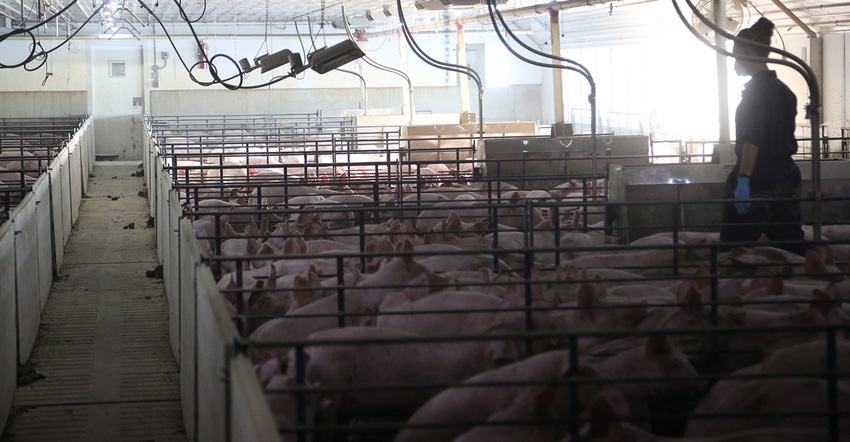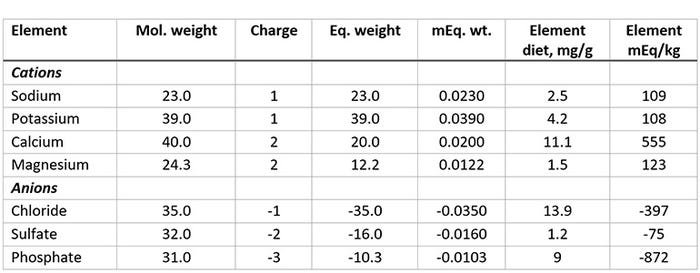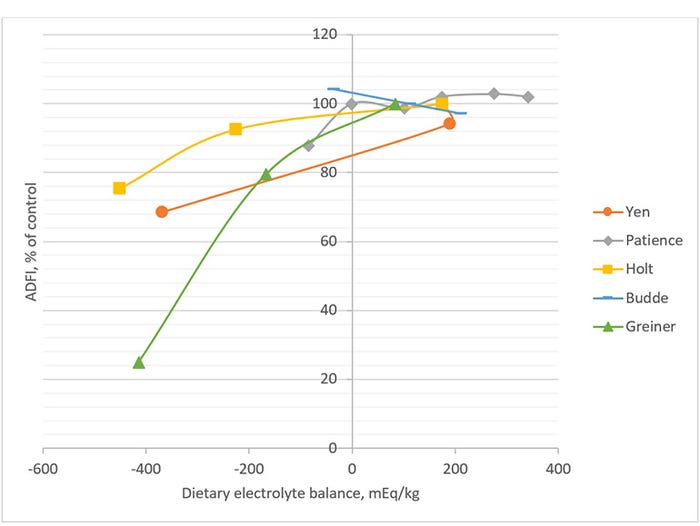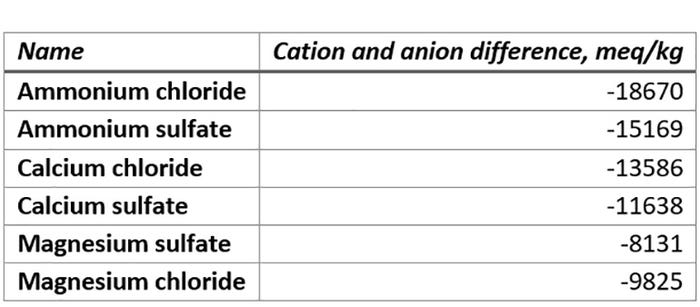Control feed intake by modifying dietary electrolyte balance
Ingredients needed to lower dietary electrolyte difference to a level that effectively lowers feed intake may not always be economical.
May 7, 2020

The impacts of the COVID-19 pandemic continue to force many changes in swine industry. One of the most detrimental problems producers are facing is closure of processing plants, leaving them with few (if any) options to sell pigs when they reach market weight.
As of this writing, some processing plants that were closed are beginning to open, but these appear to be with limited harvest capacity. Therefore, producers still need to think about strategies to reduce the number of pigs they need to market or slow the growth of pigs they are currently feeding. While there are a number of options to decrease growth rate of swine, this article will focus on modifying dietary electrolyte balance to control feed intake.
Dietary electrolyte balance is the difference of the intake between cations and anions that has an impact on intracellular and extracellular fluid balance. A prolonged negative electrolyte balance induces metabolic acidosis while a prolonged positive electrolyte balance induces metabolic alkalosis. Excess intake of anions may lead to decrease in feed intake. However, the magnitude of expected change in average daily feed intake varies among experiments in the literature. Therefore, a small database with 13 manuscripts was developed to study the overall impact of dietary electrolyte balance (dEB = Na + K – Cl).

There are several ways to express electrolyte balance that use similar information (Table 1). The simplest calculation uses sodium and potassium as the cations and chloride as the anion, referred to as dEB. The dietary cation and anion difference includes sulfur in the calculation, while the dietary undetermined anion is the most comprehensive calculation with magnesium and phosphate (Table 2).

In reviewing the literature, feed intake of pigs fed diets with dietary electrolyte difference below zero had a decrease in average daily feed intake by 5.8% for each 100 mEq decrease in dEB. As expected, the difference in feed intake among experiments and differences in dietary components among experiments result in varying responses. The greatest decrease (30%) in average daily feed intake was observed when pigs consumed 4% calcium chloride compared to a standard corn and soybean meal-based diet (Yen et al. 1981). The lowest observed feed intake in dietary electrolyte difference was when diets with a combination of calcium chloride and ammonium chloride were fed to gilts at about 125 kilograms of body weight (Holt and Walker, 2011).

The majority of experiments were conducted using calcium chloride. There are other feed ingredients that also have low dietary electrolyte difference (Table 3). The addition of calcium chloride allows decrease in dEB but dietary calcium increases significantly. Therefore, a combination of ammonium chloride and calcium chloride can be an alternative way to decrease dietary electrolyte balance while still maintaining proper calcium and phosphorus ratio.

Lowering dietary electrolyte balance is an effective way to reduce feed intake of growing pigs. However, Holt and Walker (2011) also observed that gilts fed with low DCAD diets appeared to adapt to the diet and feed intake began to increase after four weeks. Therefore, it may be necessary to continually evaluate dietary electrolyte balance for maximum reduction in feed intake.
Also, the ingredients needed to lower dietary electrolyte difference to a level that effectively lowers feed intake may not always be economical. Work with your nutritionist or Extension specialist to assist with these technical changes in formulation. The authors also welcome any questions you might have.
References
Budde, R.A and T.D. Crenshaw. 2003. Chronic metabolic acid load induced by changes in dietary electrolyte balance increased chloride retention but did not compromise bone in growing swine. J. Anim. Sci. 81:197-208. doi: 10.2527/2003.811197x
Dersjant-Li, Y., M.W.A. Verstegen, H. Schulze, T. Zandstra, H. Boer, J.W. Schrama, and J.A.J. Verreth. 2001. Performance, digesta characteristics, nutrient flux, plasma composition, and organ weight in pigs as affected by dietary cation anion difference and nonstarch polysaccharide. J. Anim. Sci. 79:1840-1848.
Greiner, L., J. Patience, and N. Gabler. 2020. Project Preliminary data: Nutritional approaches to reduce feed intake and growth rate in finishing pigs. Version 4. Accessed May 6, 2020.
Guzman-Pino, S.A., D. Sola-Oriol, R. Davin, E.G. Manzanilla, and J.F. Perez. 2015. Influence of dietary electrolyte balance on feed preference and growth performance of postweaned piglets. J. Anim. Sci. 93:2840-2848. doi: 10.2527/jas.2014-8380
Haydon, K.D., J.W. West, and M.N. Mccarter. 1990. Effects of dietary electr. J. Anim. Sciece:2400-2406.
Holt, J.P. and P. Walker. 2011. Regulating Feed Intake of Group Housed Replacement Gilts by Altering Dietary Cation/Anion Difference — NPB #10-042. Report to the National Pork Board. Des Moines, IA.
Patience, J.F., and R.K. Chaplin. 1997. The Relationship among Dietary Undetermined Anion, Acid-Base Balance, and Nutrient Metabolism in Swine. J. Anim. Sci. 75:2445-2452. doi: 10.2527/1997.7592445x
Patience, J.F., R.E. Austic, and R.D. Boyd. 1987. Effect of Dietary Electrolyte Balance on Growth and Acid-Base Status in Swine. J. Anim. Sci. 64:457-466. doi: 10.2527/jas1987.642457x
Yen, J.T., W.G. Pond, and R.L. Prior. 1981. Calcium Chloride as a Regulator of Feed Intake and Weight Gain in Pigs1. J. Anim. Sci. 52:778-782. doi: 10.2527/jas1981.524778x
Sources: Jonathan Holt and Pedro Urriola, who are solely responsible for the information provided, and wholly own the information. Informa Business Media and all its subsidiaries are not responsible for any of the content contained in this information asset.
You May Also Like



